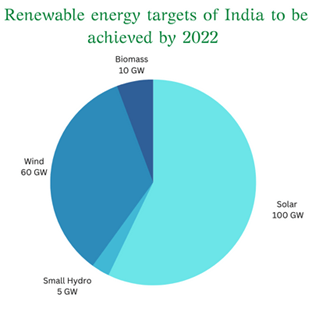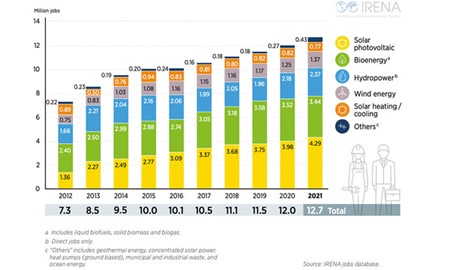CONTENTS
- India to Dominate the Global Solar Industry
- Upholding the Essence of Agriculture Amidst Market Pressures
India to Dominate the Global Solar Industry
Context:
The solar manufacturing sector in India is currently at a crucial juncture, presenting substantial opportunities for growth and employment. Historically, India has lagged behind in solar industry manufacturing, heavily relying on imports and expertise from foreign markets. This reliance has resulted in a shortage of skilled manpower and a lack of indigenous technological capabilities.
Relevance:
GS-2
Government Policies and Interventions
GS-3
- Solar Energy
- Renewable Energy
- Infrastructure
Mains Question:
The solar manufacturing sector in India is at a critical juncture, teeming with potential for high growth and an abundance of employment opportunities. Analyse. (15 Marks, 250 Words).
Solar Energy Sector in India:
- In the year 2010, India had a solar PV capacity of less than 10 MW. Over the past decade, there has been significant growth, with the country achieving a capacity of over 50 GW by 2022.
- Looking ahead to 2030, India has set a target of deploying approximately 500 GW of renewable energy, with an anticipated contribution of around 280 GW from solar PV.
- To meet this goal, there is a need for the addition of 30 GW of solar capacity each year until 2030.
- Currently, India’s solar module manufacturing capacity is limited to approximately 15 GW per year, and the remaining demand is fulfilled through imports.
- Notably, around 85 percent of this import requirement is sourced from three countries—China, along with Vietnam and Malaysia.
- The total value of solar imports since 2014 amounts to $12.93 billion, equivalent to Rs 90,000 crore.

Solar Manufacturing Sector:
- From a human resources perspective, the solar manufacturing sector poses both challenges and opportunities.
- The spillover effect of manufacturing is particularly notable, creating employment not only within the industry but also generating a ripple effect across related sectors.
- With the global demand for solar products on the rise, the need for skilled workers in manufacturing, project planning, and execution is becoming increasingly evident.
- India’s dependence on imports has hindered the development of a robust solar manufacturing ecosystem.

Transformative Shift:
- However, a positive shift is underway as both Central and State governments focus on promoting manufacturing.
- Initiatives such as “Make in India” and incentives for the solar industry are expected to create a favorable environment for skill development within the country.
- The solar manufacturing sector in India is undergoing a transformative phase, transitioning from reliance on imports to the development of indigenous capabilities.
- Despite historical challenges related to skill shortages and limited technological expertise, collaborative efforts from the government and industry stakeholders are driving substantial advancements.
- Initiatives like “Make in India” and incentivization programs are fueling the growth of a resilient manufacturing ecosystem.
- Nevertheless, challenges persist, especially in addressing the scarcity of skilled workers and enhancing project planning and execution capabilities. Overcoming these hurdles will require continued collaboration across industries and sustained government support.
Challenges Ahead:
- A significant challenge lies in the limited pool of skilled workers and a lack of experience in project planning and execution within the solar manufacturing domain. Addressing this challenge requires mobilizing cross-industry resources to fill existing gaps.
- With the improving demand scenario and concerted efforts by the Indian government to boost manufacturing, the solar sector is poised for substantial expansion.
- Furthermore, as industrial manufacturing scales up, it is likely to drive advancements in research and development, contributing high-level technological inventions and innovations from Indian institutions.
- Positioned to play a significant role in employment, economic growth, and sustainability, India’s solar manufacturing sector is aligning itself with global competitors in scale and technology.
- Through the implementation of appropriate HR strategies and government backing, India has the potential to establish itself as a crucial participant in the solar manufacturing arena in the foreseeable future.
Conclusion:
As India aligns itself with global standards in both scale and technology, the solar manufacturing sector is poised to become a cornerstone of employment, economic growth, and sustainability. Through effective HR strategies and ongoing government support, India is well-positioned to emerge as a significant player in the global solar manufacturing landscape in the years ahead.
Upholding the Essence of Agriculture Amidst Market Pressures
Context:
Agriculture, often considered the foundation of all human cultures and production methods, revolves around values related to human existence, health, and welfare. Market values are overlaid onto agricultural production and consumption. For many farmers, agriculture serves not only as a source of income and livelihood but also as a way of life and identity.
Relevance:
Issues related to Direct and Indirect Farm Subsidies and Minimum Support Prices
Mains Question:
With reference to the ongoing farmers’ protest, discuss how the demands of Indian farmers have evolved over the years and what steps have been taken by the government to meet those demands. (10 Marks, 150 Words).
Significance of the Agricultural Sector:
- Agriculture serves as a vital platform for achieving objectives such as food security, rural development, cultural heritage preservation, and landscape conservation.
- Consequently, there is a need for protective mechanisms to shield agriculture from the post-industrial market economy, which prioritizes profit over goodwill and well-being.
- The market introduces a conflict between the economic and social goals of agriculture. The Indian farmers’ protest for a legal guarantee on the minimum support price is justified by the social objectives of ‘food security’ and the livelihood of farmers.
Minimum Support Price:
- The minimum support price system, initiated in 1966 to address India’s food deficit, has been a driving force for development and food safety for the Indian population.
- Although the system to determine the minimum support price has evolved over the years, there is still room for improvement and support.
- Currently, the Commission for Agricultural Costs and Prices (CACP), under the Government of India, computes the paid-out costs for seeds, fertilizers, pesticides, hired human and machine labor, and leased-in land rent, labelled as A2.
- Additionally, it includes the imputed value of unpaid family labor (FL) and adds 50% of the total to propose the minimum support price (MSP) for various agricultural products such as Cereals (Paddy, Wheat, Barley, Jowar, Bajra, Maize, and Ragi), pulses (Gram, Arhar/Tur, Moong, Urad, and Lentil), oilseeds (Groundnut, Rapeseed/Mustard, Toria, Soybean, Sunflower Seed, Sesamum, Safflower Seed, and Nigerseed), Copra, De-Husked Coconut, Raw Cotton, Raw Jute, and Sugarcane on an annual basis.
- The CACP’s recommendation is then subject to approval by the Indian Parliament before the sowing season, considering factors such as production costs, fair remuneration for farmers, affordability for consumers, and prevailing market conditions.
Recent Demands of the Farmers:
- The CACP does not fully incorporate the recommendations of the ‘Swaminathan National Commission for Farmers,’ particularly the inclusion of capital assets and the consideration of rentals and interest forgone on owned land, which are among the demands of the protesting farmers.
- Another aspect contributing to the farmers’ protest is the call for legislation granting farmers the ‘Right to Sell at MSP,’ a suggestion that the CACP itself proposed in its price policy report for the year 2018-19.
- The farmers are advocating for a legal safeguard for their produce to shield it from the market dynamics of ‘demand and supply.’
- They express concerns about potential manipulation by private traders and corporations, echoing apprehensions highlighted by the CACP in its 2018-19 report.
Analysing the Demands:
- Unlike industrial production, agricultural crops lack the resilience to easily withstand market pressures, and shifting cropping patterns is not a straightforward task.
- The inherent biological nature of agricultural produce exposes it to unpredictable weather conditions, pests, and diseases.
- Moreover, the simultaneous and singular yield of crops makes them susceptible to market players if left unguarded.
- A legal guarantee for the Minimum Support Price (MSP) is essential to enhance the resilience of agricultural produce against adverse market forces.
- Small farmers, unlike corporations, lack the capacity to store and add value to their produce; they are compelled to sell their entire yield immediately. Therefore, it is reasonable for farmers to anticipate a guaranteed MSP announced by the government.
- The legal assurance for MSP does not entail the government procuring the entire crop. Instead, it pertains to the purchase of the crop at a price not lower than the minimum remunerative price declared by the government.
- In the absence of a legal guarantee, traders may acquire agricultural produce at prices below the MSP, subsequently selling it to consumers at prices much higher than the MSP without passing on the benefits to the consumers.
- Agricultural produce is essential for survival, unlike other industrial or service products that provide additional comfort.
- To ensure farmers continue producing enough for the population’s survival, it is entirely reasonable for the government to fill the gaps when ‘demand and supply’ forces lead to crop sales at prices below the Minimum Support Price (MSP). This approach aligns with the government’s intervention principle to support corporate failures.
Conclusion:
Establishing a legal guarantee for all crops across all states can serve as a tool for promoting organic farming and diversification. If left vulnerable to the ‘demand-supply’ principle without adequate protection, it could result in food insecurity and compromise the social values inherent in agriculture. Allowing agriculture to be solely governed by market forces is neither desirable nor in the best interests of the nation; it tends to be pro-corporate and anti-national.




